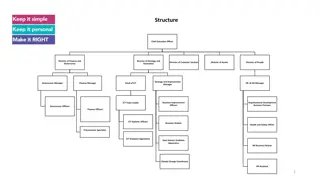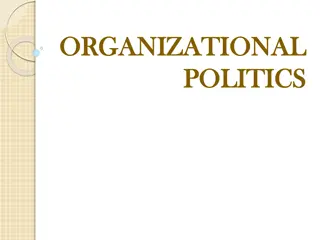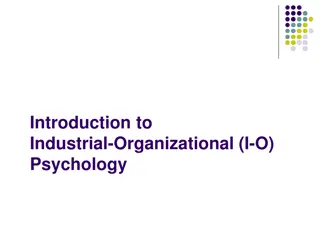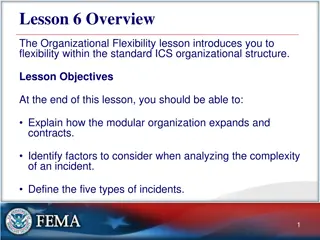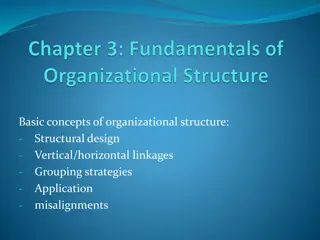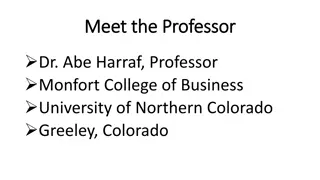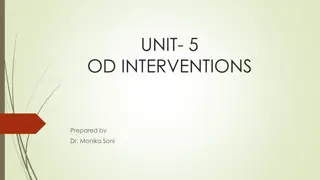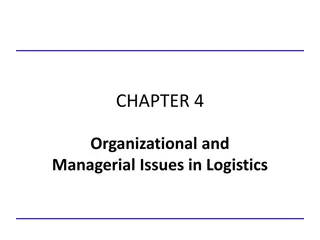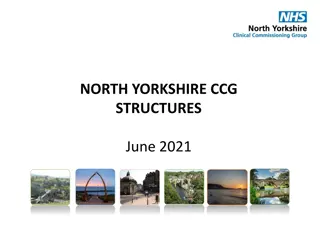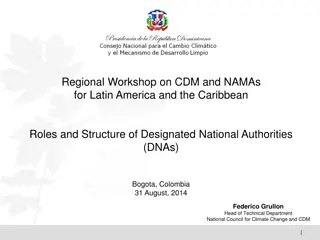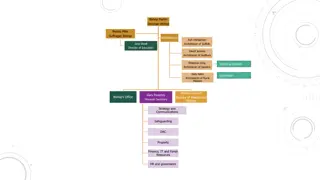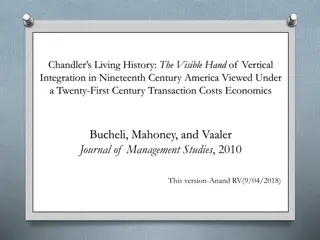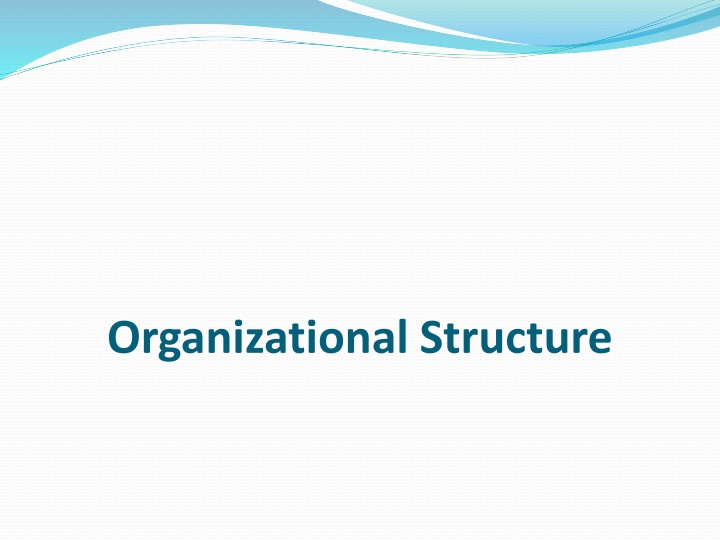
Organizational Structures and Their Advantages
Explore different organizational structures such as functional and divisional, their benefits, and drawbacks. Learn how structural choices impact efficiency, communication, and innovation within an organization.
Download Presentation

Please find below an Image/Link to download the presentation.
The content on the website is provided AS IS for your information and personal use only. It may not be sold, licensed, or shared on other websites without obtaining consent from the author. If you encounter any issues during the download, it is possible that the publisher has removed the file from their server.
You are allowed to download the files provided on this website for personal or commercial use, subject to the condition that they are used lawfully. All files are the property of their respective owners.
The content on the website is provided AS IS for your information and personal use only. It may not be sold, licensed, or shared on other websites without obtaining consent from the author.
E N D
Presentation Transcript
The Basis of Strategy : Structure Structure is the allocation and control of work tasks This implies power relationships based on the acceptance of managerial power by subordinates. All organizations have some form of structure, based on the established pattern of relationships among the individuals, groups and departments within it Broadly speaking, there are two structures -- a vertical structure of authority and responsibility where clear limits of financial authority exist, and a horizontal structure of groupings of activities designed to use the resources towards goal- attainment.
Functional Structure Divides organization up into its main activities or functions Similar specialist activities are grouped together into independent and interdependent departments
Advantages of Functional Structure Specialized resources are used efficiently. Quality is enhanced by other specialists from the same functional area. Opportunities exist for extensive division of labor. A career structure enables people to advance within their functional specialism. It is easier to manage specialists if they are grouped together, especially when the manager has the same experience. It fosters communication between specialists and enhances the development of skill and knowledge. It does not duplicate specialist resources throughout the organization and promotes economies of scale. It is suited to conditions which stress functional specialism, where the environment is stable, and when the technology is routine, requiring little interdependence between departments.
Disadvantages of Functional Structure Increased need for interdepartmental co-ordination and scheduling. Communication, co-ordination overload the vertical hierarchy. Inefficient co-ordination of functional departments. Responsibility for overall outcomes is unclear. Interdepartmental conflicts. Little creativity and innovation. When the organization reaches a certain size, they are likely to be exacerbated especially if it has developed a wide range of products or services. (Burns and Stalker (1961) devised the term mechanistic for firms where the interconnections are strong as they are unsuited to changeable environments and non-routine technologies)
Divisional Structure A divisional structure can help to overcome the limitations of a functional structure, as it contains within it functional specialists but groups its activities around products or geographical regions. These two ways of grouping activities are supposed to ensure a closeness to the customer which is not really possible in a functional structure.
Advantages of Divisional Structure It provides excellent co-ordination across functional departments. Since departmental units are often small as well as self- contained, employees identify with the product or project rather than their own function. Since each division can, for example, react to customer requirements, it is well suited to changeable environments.
Example: Alfred Sloan (1965) developed a true divisional structure for the disparate firms owned by General Motors Corporation in the 1930s, bringing together a central function to garner expertise from the different firms such as Pontiac, Cadillac and Chevrolet. GM leap-frogged over Ford, who had a functional structure, and has kept its lead ever since
Disadvantages of Divisional Structure There may be a costly duplication of resources across departments. Specialists may become isolated and fail to further their specialist skills. Competing demands on people may create stress. Co-ordination across divisions is difficult. Tension between the centre and divisions is a crucial problem of control. Too much control stifles innovation Divisional CEOs gain too much power and can introduce wild excesses of spending on favored pet projects (Example: in Rolls-Royce the RB211 engine project overruns nearly bankrupted the company)
Product Based Structure People and resources are grouped according to an organization's products. Eg. General Motors, has specific products - Chevrolet, Cadillac, Pontiac. This enables technical excellence and concentration on fewer product lines, and a liaison with a smaller set of customers, realizing more creativity in marketing and sales through focus, teamwork and goal consensus. This format is used most successfully where there is a variety of products, each addressing different markets
Geographical Structure Where organizations have few products, such as IBM, they may group activities according to sales area and be literally closer to the customer. This enables regional differences to appear in marketing research. In this way IBM gets to know the details of the businesses in an area and its sales team focus on local contacts. For example, meeting senior people from potential clients informally at the golf club or race track
BOD CEO GM Corporate Asia Pacific MENA Europe M F IT M F IT M F IT
Advantages of Geographical Structure Communication and collaboration Local Managers Geographical Focus Performance Measurement and Strategy
Disadvantages of Geographical Structure Duplication of Activities and Infrastructure Cannot utilize economies of scale Unfair competition in allocation of resources Expertise and skills will get isolated to one place
Matrix Structure Divisionalisation may eventually have to be adapted to include formal mechanisms to promote closer inter-divisional collaboration and the result will be a matrix structure in which vertical and horizontal formal relationships are recognized. A matrix structure seeks to add flexibility and lateral co-ordination to the traditional vertical hierarchy. One way of doing this is to create project teams made up of members drawn from a variety of different functions or divisions: each individual then has a dual role, as he or she maintains functional/divisional responsibilities as well as membership of the project team. (Example: US President John F Kennedy demanded a man on the moon within ten years . The achievement of this goal was apparently due to the new structure NASA adopted to link the functional specialists in the background departments intimately with the problem-solvers on the construction and research and development team for the Apollo mission. This mixture became known as a matrix .)
Advantages Improves decision-making by bringing a wide range of expertise to problems that cut across departmental or divisional boundaries; Replaces formal control by direct contact; Assists in the development of managers by exposing them to company-wide problems and decisions Improves lateral communication and co-operation between specialists. Suits rapidly changing environments because the equal balance of power between functional and product management aids communication and co-ordination. Facilitates adaptation to unfamiliar and unexpected problems. People can be flexibly relocated across products or projects, aiding the speedy implementation of new ones. Employees have the opportunity to develop either functional or general management skills. It is useful for medium-sized organizations with a medium number of products or for task-centred organisations.
Disadvantages A lack of clear responsibility; Clashes of priority between product and function; Functions lose control of the psychological contract; Career development can often be stymied Difficult for one specialist to appraise performance of another discipline in multi-skilled teams Project managers are reluctant to impose authority as they may be subordinates in a later project Employees may be confused by reporting to two bosses; Managers will need to be able to resolve interpersonal frictions and may need training in human relations skills Managers spend a great deal of time in meetings to prioritise tasks. The complexity of the matrix structure makes it difficult to implement successfully.
Exercise Peters and Waterman (1982, p. 307) state: Our favorite candidate for the wrong kind of complex response, of course, is the matrix organization structure. People aren t sure to whom they should report for what the organization gets paralyzed because the structure not only does not make priorities clear, it automatically dilutes priorities. In effect, it says to people down the line everything is important, pay equal attention to everything. Q: How convinced are you by the criticisms of matrix structures put forward by Peters and Waterman? Do you think there are some types of situations when this form of organization would work well?
Alfred Sloan (1875-1966) Alfred Sloan was not only arguably the most original CEO and organizational thinker of the 20th century, but he was also clever enough to set his record down in a book that has become a management classic: My Years with General Motors , written with the help of John McDonald, an editor from Fortune magazine, and a rising young historian called Alfred Chandler.
He reorganized the company in a way that became the template for virtually every corporate entity for the rest of the century. He divided the company into separate autonomous divisions that were subject only to financial and policy controls from a small central staff. This federal decentralization , as he called it, is said to have taken only a month to set up, but its results were enduring and dramatic. Within six years the company had moved from being a laggard in the industry (way behind Ford with its famous Model T) to being the market leader with a turnover of $1.5 billion and a share price that had almost quintupled.
Sloan also introduced a systematic strategic planning procedure for the company's divisions, the first CEO ever to do such a thing. Each GM model was changed and updated annually, and models were designed not to compete with each other a strategy that effectively made Sloan the inventor of the second-hand car market. His aim was to produce a car for every purse and purpose , unlike Ford, which stuck with its single model understandably since, when Sloan took over at GM, Ford had some 60% of the market, compared with GM's 12%. This profile is adapted from The Economist Guide to Management Ideas and Gurus , by Tim Hindle (Profile Books; 322 pages). The guide has the low- down on more than 50 of the world's most influential management thinkers past and present and over 100 of the most influential business-management ideas.



